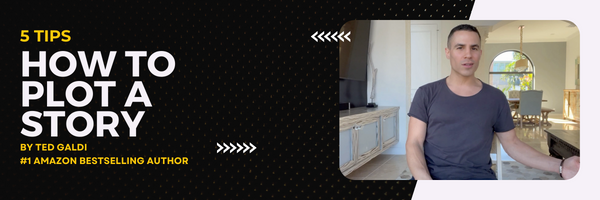Story Plot: 5 Writing TipsDon't miss these 5 tips for your story plot below. Deliver a book or screenplay your audience loves. Want to write an awesome story? Download my FREE outlining guide. Hook, captivate, and wow with your plotIf you're writing a book, screenplay, or any other type of story, you want to hook your audience at the beginning, keep it captivated through the middle, and wow it with an exciting ending. Story Plot Tip #1: Shake up your protagonist's world with an inciting incidentThe very beginning of your story should be focused on characterizing your protagonist and possibly some of their allies. No major conflict has necessarily begun yet. You can show your hero working, interacting with friends, or doing just about anything else that composes their status quo. Then, things change. The inciting incident is an event that shakes up your hero's world. It typically occurs toward the beginning - but not always the very beginning - of your story. An example of an inciting incident in a mystery could be a young woman vanishing. In a romance, it could be your hero's fiance leaving her a week before their wedding. The inciting incident directly leads to something known as the call to adventure, which is a challenge the hero is lured to take on. In the mystery story just mentioned, the call to adventure could be the hero - say, a retired detective - coming out of retirement to help find the missing woman. In the romance, the call to adventure could be the engaged woman who was left pre-wedding venturing back into the dating world after being out of it for five years. If you'd like more writing tips for creating your story's hero, have a look at my post on character development for your protagonist. Story Plot Tip #2: Give the hero something to loseThe term "stakes" refers to what the hero stands to lose if they don't accomplish the call to adventure's challenge. Giving the hero something to lose builds an emotional connection between the character and the audience and enhances the drama of your story plot. For example, in the mystery discussed, if the detective doesn't accomplish his goal of finding the missing woman, his long-standing reputation as the town's best police officer will be tarnished. That reputation means a lot to him, meaning he has a lot to lose if he fails. Story Plot Tip #3: Complicate the challenge with tough opponentsTo build drama, your hero's goal should be difficult to attain. Turn up the conflict with formidable opponents. In the mystery we've been talking about, the hero cop is searching for a missing woman, while the criminal who abducted her is trying to evade suspicion. Give this criminal - the central villain - a skillset that makes him hard to catch. The villain could be be technologically crafty, able to destroy digital footprints leading to him. In addition to your central villain, incorporate other opponents who'll apply pressure to your hero in different ways. For example, a younger cop on the police force is jealous of the hero and attempts to sabotage the hero's investigation so he can find the missing woman first and get the credit. For added effect, one of your opponents can be revealed to your hero as a surprise relatively late in the story. For instance, a character your hero thought was an ally could be exposed in a twist as an accomplice to the villain. This twist shouldn't just go into the story for a shock factor, but move the plot forward, ideally complicating your hero's challenge even more. For example, since your hero wasn't expecting this character to be a problem, your hero is led into a trap by him. Once the surprise opponent's true intentions are revealed, your hero is stuck in an isolated cabin with this dangerous liar, unarmed. If you want more writing tips for opponents, check out my post on character development for your villain. Story Plot Tip #4: Raise the stakesAs mentioned, stakes refer to what your hero stands to lose if they fail to accomplish their goal. Through the story, as the hero runs into obstacles from opponents, the stakes should grow in scope - your hero should stand to lose more than at the start of the story. For example, in our detective story, at the beginning, the hero's reputation as a top cop is on the line. Through the the story, the character's reputation remains at stake. However, the villain winds up learning that the hero is after him and getting close. To remain uncaught, the villain tries to murder the hero. Now, a lot more is at stake than the hero's reputation - if the villain remains on the loose, the hero could end up dead. Story Plot Tip #5: End with a showdownAfter your story's climax, the audience should have an answer to whether the hero accomplishes their goal. To build up drama before that answer is revealed, the climax should be your story's most intense scene. Structuring the scene as a showdown between your hero and central villain is an effective way to deliver that intensity. In a crime, action, or thriller story, the idea of a showdown may seem pretty evident - the hero and villain could face off in a gunfight or car chase. However, the idea of a showdown can be applied to any genre. No need for guns or explosions. In a story about art, for instance, the climactic showdown could involve painting. The villain - a painter who cheats their way into a big art competition by stealing the hero's painting - is exhibiting it to the judges. The hero, who begins the story as timid and gains the confidence to stand up for herself, breaks into the building and paints something on the wall, much better than the painting the villain stole. The judges are at first disturbed by the break-in, however, soon notice the quality of the painting and are forced to give the hero the prize. If you want even more writing tips, be sure to download my FREE story-outlining guide:
0 Comments
Leave a Reply. |


 RSS Feed
RSS Feed